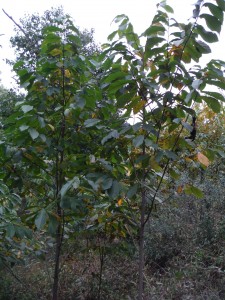Pawpaws make a great tree for yards and gardens. As an ornamental, it has an attractive tropical look with long, full, oval leaves and a small pyramidal stature suitable to smaller yards. Further, it serves as a host for the Zebra Swallowtail butterfly and makes for wonderful butterfly gardens. It also is grown for its delicious fruit, which will set on 5-6 years after planting.
The pawpaw is well adapted to the Eastern U.S. climate and soil conditions. Pawpaw is adapted to humid temperate zone growing conditions. It is hardy to the USDA growing zone 5 (-20°F or -29°C), and needs at least 400 hours in annual chilling requirements (time exposed to 35° to 45°F during winter months, depending on the cultivar). This is a low chill requirement compared to other tree fruit species (apples 800 to 1,700 hours), and once met, the trees will begin to flower early in the spring. A long, warm season is required to mature fruit (2,600 degree days; ~160 frost-free days). From 30 to 35 inches of rainfall is needed annually, with the majority falling in the spring and summer. Contrary to popular belief, pawpaw performs best in full-sun exposure. However, sunlight protection is needed in the first year in the field, as young tree shoots are sensitive to sunlight. In an orchard setting, this is accomplished by using commercially available tree shelters.
Pawpaws should be planted at a site that would be appropriate for production of tree fruit such as apples and peaches. A sloping orchard with good air drainage will reduce the risk of damage from spring frosts. The location for planting should have deep (3 feet is optimal), well drained, fertile soil with a pH of 5.5 to 7.0. Irrigation and weed control is also important for tree establishment. We recommend a planting distance of 8’ between trees. Trees seldom grow higher than 25 feet and develop a nice pyramidal shape in full sun. For maturing trees, we recommend only corrective pruning. Remove limbs to about 2.5 feet from the ground. Remove limbs that cross and any diseased wood. Prune in late winter or early spring before bud break.
Historically, pawpaws have been a difficult tree species to propagate. What appear to be small pawpaw trees in a wild patch can often be rootsuckers that have poorly developed root systems and often do not survive transplanting. Further, pawpaw seeds are desiccation sensitive and require stratification to germinate. As such, it is best to buy a tree from a commercial clonal propagation source of select cultivars. When purchasing trees, consider the advantages of grafted trees over seedlings. Seedlings undergo a period of juvenility and require a period of 5-8 years before producing flowers. Seedling fruit quality can also be poor. Grafted cultivars can produce flowers 3 years after planting. Grafted trees also have a known fruit quality, but take about 5-6 years to reach full fruit production.
Pawpaws have few pests and can be grown organically. Japanese beetles can cause damage, but usually beetles prefer feeding on other plants. If there is poor fruit set on a tree, it can often be from a lack of sunlight. However, Pawpaw trees often sucker profusely and large patches can be clonal. If genetically different trees are not nearby for pollination, fruit set can also be low. Therefore, it is critical to have genetically varied trees if you seek to grow your own fruit. Finally, remember, flies and beetles, not bees are the major pollinators of pawpaw, and a lack of pollinators can also lead to poor fruit set.


